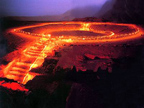
The age of two ancient bustling metropolises has been
confirmed recently by radiocarbon dating. They are located in different
hemispheres and are older than the pyramids of Egypt.
One is located at the Qoli Darvish site near the city of Qom in the Central
Iranian Plateau. Archaeological evidence supports the theory that it was a
thriving city in the early Bronze Age, with all political, religious and
governmental structures in place.
British archaeologists at Oxford University determined that the site dates back
5000 years by studying 22 lab samples sent to them by Iranian archaeologists.
The other was found ten years ago in the Supe Valley of Peru nearly 200
kilometers north of Lima. The evidence from the site known as Caral shatters the
belief that civilization got a late start in the new world. About 2600 BCE the
people here began to create a full fledged urban civilization. They built huge
public works, developed a sophisticated and diversified economy and erected at
least six large pyramids and many smaller ones, two circular plazas, temples,
amphitheatres, and residential districts.
Ruth Shady Solis, an archaeologist from the National University of San Marcos,
Lima, states that Caral was born in trade and peace and not bloodshed. “Great
civilizations are born in peace”.
This evidence suggests that if we reflected on the roots of “our civilization,”
given that there have been earlier civilizations based perhaps upon principles
of peace, community and ceremony, that we might have something to learn from the
past.